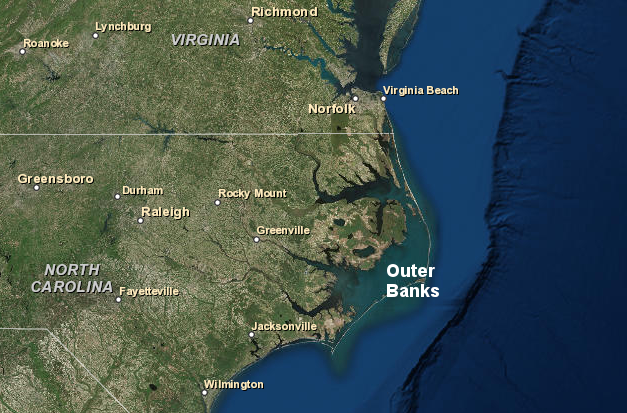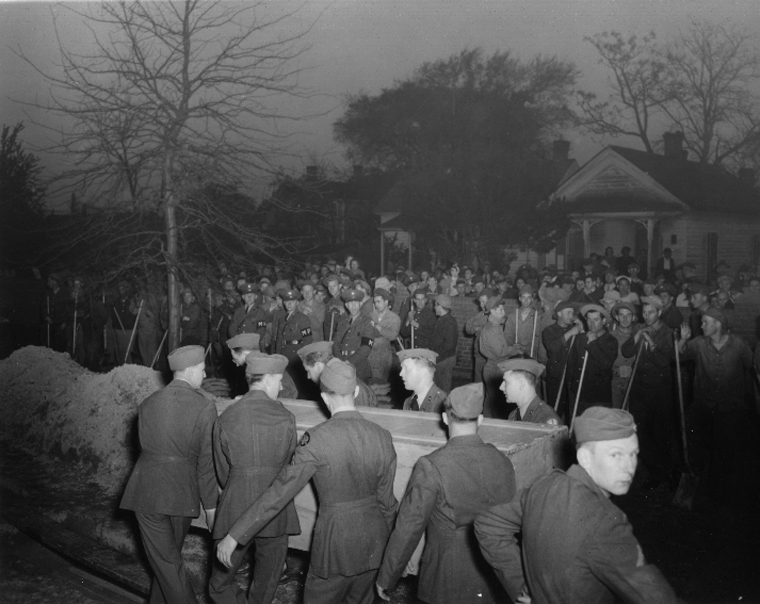
the narrow continental shelf off the Outer Banks allowed U-boats to hide in deep water during the day, then find ships closer to shore to attack at night
Source: ESRI, ArcGIS Online

the narrow continental shelf off the Outer Banks allowed U-boats to hide in deep water during the day, then find ships closer to shore to attack at night
Source: ESRI, ArcGIS Online
After Germany and the United State declared war in December 1941, five U-boats were sent to the East Coast to start Operation Drumbeat. Waves of other boats then followed. During the first half of 1942, the German submarines had great success in sinking Allied tankers and other cargo ships just off the East Coast of the United States. From the start of offensive operations in mid-January through March, 1942, U-boats sank 39 ships.
The first U-boat was finally sunk off the American Coast on April 14, 1942. The US destroyer USS Roper sank U-85 east of the Outer Banks, after using radar to catch it on the surface. At least one 3-inch shell from a deck gun cracked the hull of the submarine. It went underwater, and the US warship then dropped 11 depth charges.
The following day, 29 bodies were recovered from the ocean. They were buried that night in graves in Hampton National Cemetery, dug by German prisoners of war imprisoned at Fort Monroe. The burial was at night, with a full ceremony. A Catholic priest and a Protestant minister performed services, three volleys were fired, and taps was played.
The burial service was done in secret. That limited fear among coastal residents and awareness of the military situation by the German navy. However, efforts to recover the U-85 and the Enigma coding machine on board were unsuccessful. That machine was finally recovered by divers in 2001, and is on display at the Graveyard of the Atlantic Museum in North Carolina.1

the 29 bodies recovered from U-85 were buried in Hampton National Cemetery on the night of April 15, 1942
Source: Wikipedia, German submarine U-85 (1941)
The US military was warned that the U-boats were coming; the British had broken the codes of the German navy. However, the US failed to react, and even tried to hide the initial sinkings from the American public.
Destroyers were not deployed to protect shipping. Instead, the Atlantic Fleet remained dispersed from Brazil to Iceland, and top priority was given to protecting convoys sailing across the Atlantic Ocean to Iceland/Britain. Cargo ships continued to travel individually from the Gulf Coast to New York while lights on the shoreline made it easy for German submarines to spot silhouetted targets at night.2
It took six months for the American military to acquire ships and planes, to train personnel to challenge the U-boats, and to develop an effective set of defensive tactics. The US Navy and Army Air Force feuded over who had responsibility (and funding...) for aircraft patrols and bases along the seacoast. Initial efforts involved sending airplanes and ships on patrol to find and destroy U-boats, including two from Langley Field starting on December 8, 1941, but the Army and Navy did not share information initially from their patrols and the needle-in-the-haystack approach rarely had success.3
Even into 1943, the zones of greatest danger on the East Coast were near the ports of Boston and New York, the mouths of the Delaware River and the Chesapeake Bay, and off Cape Hatteras. The narrow continental shelf near the Outer Banks enabled submarines to make night attacks on ships steaming in the 30-50-mile wide stretch between the coastline and Gulf Stream, then take advantage of the underwater topography and spend the day hovering just a few feet above the ocean bottom in deep water. In the first six months of the U-boat campaign, they sank 45 ships off the Outer Banks.4
By July 1942, coastal convoys with 40-50 merchant ships received adequate warship escorts and aerial patrols that deterred submarines from making attacks. Southbound convoys leaving Hampton Roads were identified with letters KS, while northbound convoys leaving Key West were labeled KN. The air base at Cherry Point, North Carolina served as a center of anti-submarine operations between Hampton Roads and Charleston, South Carolina. The German Navy responded by moving most U-boats to the middle of the Atlantic Ocean, where they hunted in "wolf packs," and Hitler diverted a number of submarines to protect the German ships carrying iron ore and nickel along the Norwegian coast.5
In June, 1942, as the German Navy recognized American tactics were changing and the "happy time" of sinking unprotected merchant ships was ending, U-701 penetrated into the Thimble Shoal channel of the Chesapeake Bay and laid a minefield. That was not a new concept; U-boats had also laid mines in World War I off different American ports that sank six ships. The U-701 minefield in the Thimble Shoal channel damaged or sank 5 ships in June, 1941. Three weeks later, U-701 was also the first German submarine to be destroyed by a US Army Air Force bomber attack from the air.6
The last U-boat attack off the East Coast occurred on May 7, 1945. U-853 sank the SS Black Point, which had loaded up with coal in Norfolk and was off the coast of Rhode Island. Grand Admiral Karl Donitz, who had replaced Hitler after his suicide, had ordered an end to offensive operations on May 5. The captain of the U-853 either did not receive the order, or was a glory-seeking commander (known in the German Navy as a "sore throat") who ignored it.
The US response to the attack was deadly. The U-853 was the last submarine sunk by the US Navy near the US continent, and the SS Black Point was the last US ship sunk by a U-boat in the Atlantic Ocean:7
Source: Library of Congress, Carry the fight (1943)